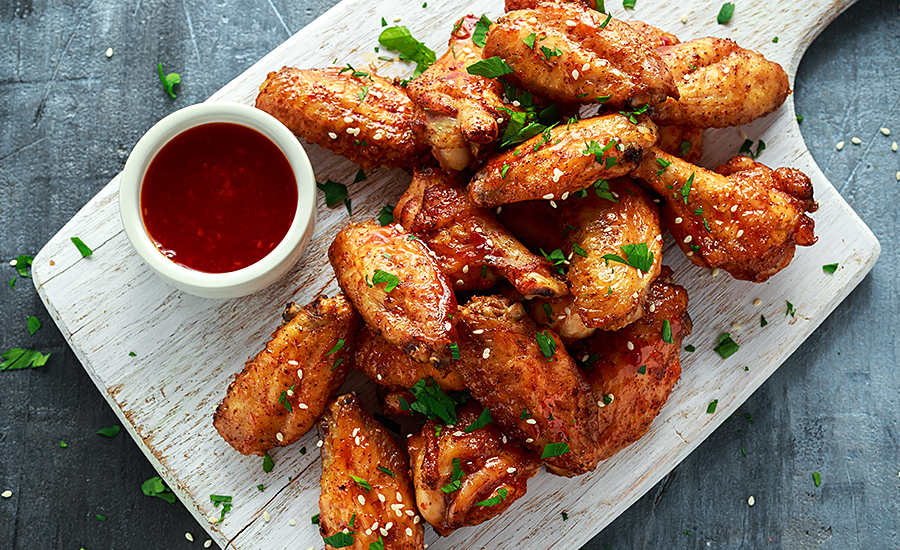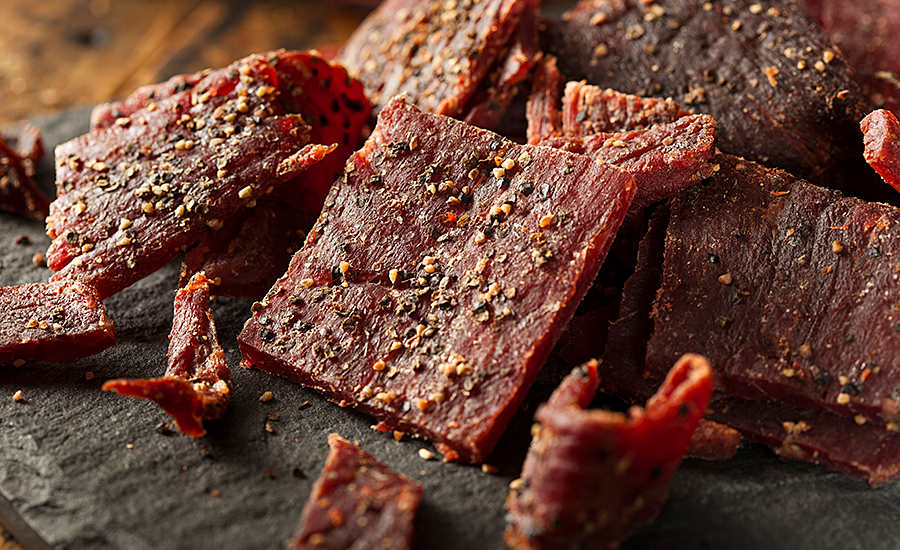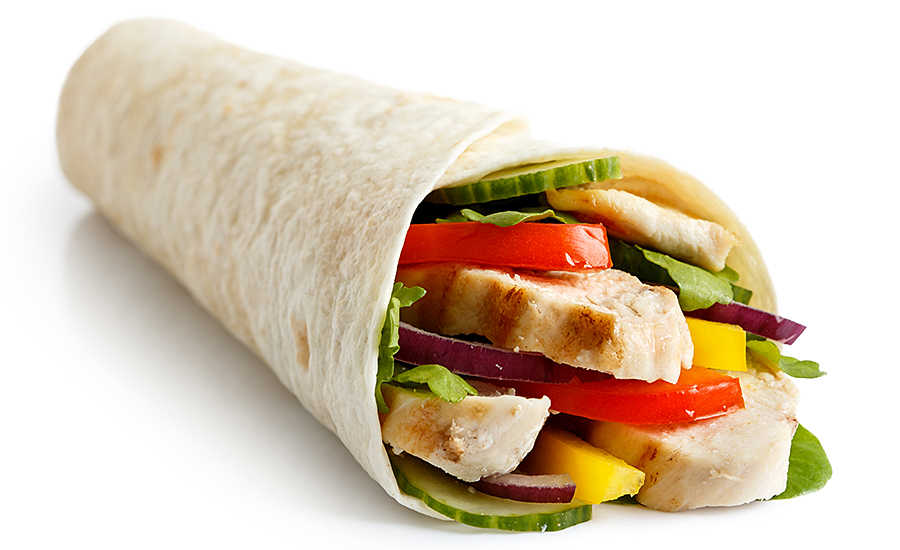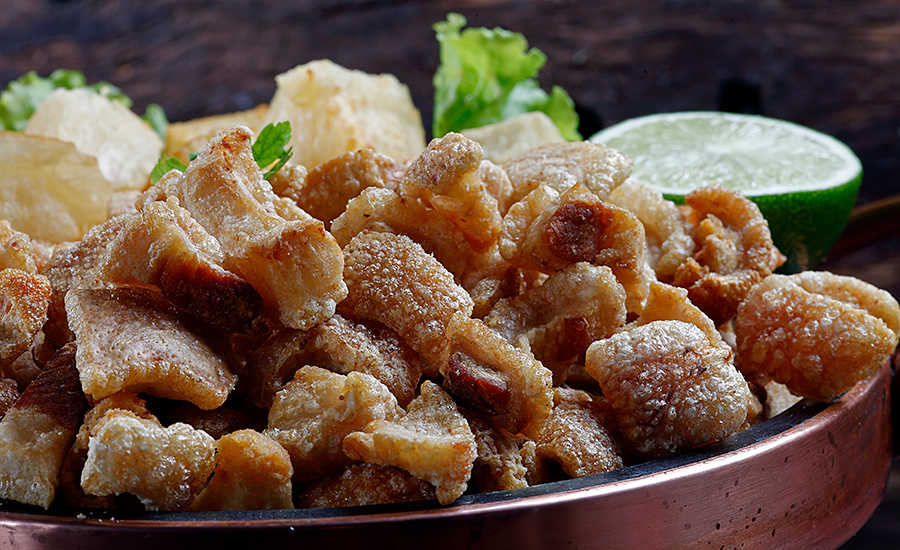The snack market is sizzling.
Sales are on the upswing as consumers look for products that meet their indulgent, nutritional and emotional needs, and meat and poultry selections are an increasingly popular part of the mix, according to Mintel Group, a Chicago-based global market research firm.
While traditional snack items such as potato chips, crackers, nuts, trail mix and tortilla chips still account for the largest share of sales and consumer penetration, meat snack activity is rapidly growing.
Meat snack sales rose 29 percent from 2018 to 2019, to an estimated $3.83 billion. This is greater than the estimated sales increases of 23.2 percent for popcorn, 19.9 percent for trail mix, 18.6 percent for tortilla chips, 15.7 percent for corn snacks, 8.9 percent for nuts, 8.4 percent for potato chips, 5.1 percent for pretzels and 1.2 percent for crackers, Mintel reports in its February 2020 Trending Flavors and Ingredients in Snacks U.S. report.
Sales of dried meats totaled $3.7 billion for the 52 weeks ending Nov. 1, 2020, up 8.5 percent versus the year earlier period, reports Information Resources Inc. (IRI), a Chicago-based market research firm. Unit sales totaled 1.1 billion, a 3.7 percent increase.
Jerky accounts for almost half of the dried-meat sales activity, with revenues totaling $1.8 billion, a 5.6 percent increase. Unit sales reached 284.5 million, a 0.1 percent gain, IRI reports.
“Consumer interest in protein snacks is at the source of segment growth,” Mintel says. “Innovation jumpstarted the segment with new product development rooted in flavor exploration, yet also tapped into eye-catching packaging, strong branding and ethically sourced proteins well targeted to the Millennial and Gen Z snacker.”
Mintel adds that pork rinds, while a small segment of the snack market, “found success through the back door of the protein trend — low or no carb. Brands are hitching their wagon to on-trend specialty diets like Keto and Paleo. Success in the segment ignited the emergence of new brands in the market.”
Consumers younger than 55 are the main drivers of snacking growth as they shift to new formats and flavors, Mintel reports, adding meat snacks and pork rinds sectors are standout categories “where millennia influence can be clearly seen. Meat snack eaters strongly skew Millennial and Gen Z while pork rind eaters skew Millennial and multicultural.”

A growing list of snack options
Suppliers are responding to growing base of consumers seeking innovative meat snacks by launching a plethora of products consisting of different brands, proteins and flavors along with health-oriented claims, diet-specific selections, functional packaging, blends of meat and vegetables and plant-based items, says Anne-Marie Roerink, president of 210 Analytics, a San Antonio-based market research and marketing strategies firm.
“That is leading to a sizeable meat section in the snack aisle and an ever-growing presence of meat snacks at the front end of supermarkets, which is the most desirable merchandising space in the store,” she says.
Both legacy and startup brands are driving innovation and broadening the audience for meat snacks, Roerink says.
“A dedicated organic shopper wouldn’t have been in the meat snack segment 10 years ago, but today there is a wide array of grass-fed, organic and no-antibiotics-ever products with a very clear health positioning,” she says. Roerink notes some offerings are intended to be part of the high-fat, low-carbohydrate Keto diet and the Paleo diet, which consists chiefly of meat, fish, vegetables and fruit.
“Much like the meat department, different brands and types appeal to different shoppers, and retailers will need to closely match their assortments to their shopper audience,” Roerink says.

Make snacking a store destination
To stand out from competitors, it is important for supermarkets to position themselves as the “snack hub” for consumers, with meat snacks part of the set, says Sally Lyons Wyatt, IRI executive vice president and practice leader.
“Even with the majority of Americans not as ‘on the go’ as before the COVID-19 restrictions, meat snacks are attracting more shoppers and generating greater sales in 2020,” she says. “This makes the category a must-have for the supermarket channel.”
Protein snacks, meanwhile, are available in a wider range of varieties, Lyons Wyatt says. She says there are more selections of chicken, turkey, bison, venison and salmon, along with additional plant-based and health-oriented types in different forms, including strips, bites, cuts, chips and bars.
Such selections as elk and low- or no-sugar options also are emerging, as are single-serve bacon snacks and blended items which might combine animal proteins and vegetables to create better-for-you alternatives, Roerink says.

A transformation for chicken snacks
Poultry merchandisers, meanwhile, are testing new snack-oriented varieties of chicken bites, chicken poppers and chicken popcorn that are available in an array of flavors and packaging and feature different vegetables, says Tom Super, senior vice president of the Washington, D.C.-based National Chicken Council. “A good number of these products will prove successful, especially because the stay-at-home crowd during the COVID-19 pandemic is tiring of the same food alternatives and are most receptive to new tastes,” he says.
Chicken roll-ups also have great snacking potential, Super says. He notes the roll-ups — which traditionally consist of ham, cheese and other compatible ingredients — can contain thinly sliced chicken breast or thigh meat along with cheeses and vegetables which consumers can eat cold, hot, as a handheld or in a wrap.
“Operators can position roll-ups for the budget-conscious food shopper as an affordable, healthy snack,” Super says. “Or go upscale with organic chicken versions that contain upscale cheeses.”
Traditional chicken snacks, including both bone-in and boneless wings, continue to be strong revenue drivers, he says. A recent National Chicken Council consumer survey found that 53 percent of Americans prefer boneless wings over bone-in selections.
“Increased eating occasions between mealtimes has brought new meaning to snacks,” Super addssays, adding that more consumers anticipate the need for mini meals or snacks by cooking extra pieces of chicken with their regular meals for planned leftovers.
Taste tops the snack hierarchy
Flavor is a powerful magnet for attracting shoppers to meat and poultry snacks.

The growth of both mature and less mainstream categories suggests “that a little flavor innovation can go a long way for both legacy and newcomers,” reports Mintel Group, a Chicago-based global market research firm.
“Consumers base their snack choices on flavor first, followed by other key choice factors such as price, naturalness, nutrition and brand,” Mintel states in its February 2020 Trending Flavors and Ingredients in Snacks U.S. report. “Mainstream flavor and ingredient innovation must be unique to appeal to mass audiences, but not so unique it’s alienating.”
Flavor exploration is fueling the launch of unconventional meat snacks, Mintel reports, noting newer options include Private Selection-branded Honey Harissa Beef Jerky; Kalahari Biltong-branded Spicy Peri Peri Beef Biltong; Fusion Jerky’s Chili Basil Artisan Turkey Jerky; Krave-branded Garlic Chili Pepper Gourmet Dried Beef Cuts; and Duke’s Hatch Green Chili Flavored Smoked Shorty Sausages.
Pork is becoming more prominent.
Flavorful pork rinds include Epic’s Cinnamon Churro Oven Baked Pork Rind, Southern Recipe Small Batch Cilantro Lime Flavored Oven Baked Pork Rinds; Field Trip Crispy Cuts’ Island BBQ Pork Rinds, Pork Clouds’ Garlic Thyme Fried Pork Rinds and 4505 Jalapeño Cheddar Chicharrones Fried Pork Rinds.
“Because snacks have to taste good and offer appealing flavor varieties, snack players will do well to hammer home the message of good taste and enjoyment,” Mintel reports. In fact,79 percent of respondents in a November 2018 Mintel survey of 1,899 Internet users ages 18 and older agreed flavor is more important than brand when choosing a snack, and 52 percent noted taste is more important than health when eating snacks.
“While a large contingency of snackers wish there were more healthy snack options, slightly more than half say taste trumps health,” Mintel reports. “The solution is a mix of both health and indulgence, and all signs point to flavor being the catalyst to bridge the gap between the two.”
Mintel adds that while consumers enjoy the flavors they know and love, “snack brands can keep things interesting with new flavor combinations and new spins on classics. While classic flavors such as barbecue, salt, garlic, ranch and jalapeño dominate consumers’ current flavor repertoire, snackers express the highest interest in next-level herbal, vegetable and spicy flavors such as basil, avocado and sweet chili that carry fresh and real ingredient perception.”
— Richard Mitchell
Sustain sales momentum with astute marketing
Changing shopper habits hold down potential for meat snack activity. In the age of COVID-19, consumers are making fewer shopping trips, which results in decreased traffic in stores’ snack areas, Roerink says. In response, retailers should make meat snacks more visible to the consumers that are visiting retail outlets by placing secondary meat snack layouts in areas throughout the store to drive impulse purchases.
Other effective merchandising techniques include using social and digital media to spotlight varieties, pricing and the scope of meat snacks, and by placing products with similar attributes together in snack sections, such as those that are higher in protein or gluten free, to make it easier for shoppers to find what they’re looking for, Lyons Wyatt says.
She also says more operators seek to enhance the appeal of meat snacks by using resealable packaging that keeps products fresh longer; offering more unconventional flavors, including sweet, savory and sweet and savory combinations; and emphasizing sustainability by spotlighting ethical and humane farming and sourcing. NP










Report Abusive Comment